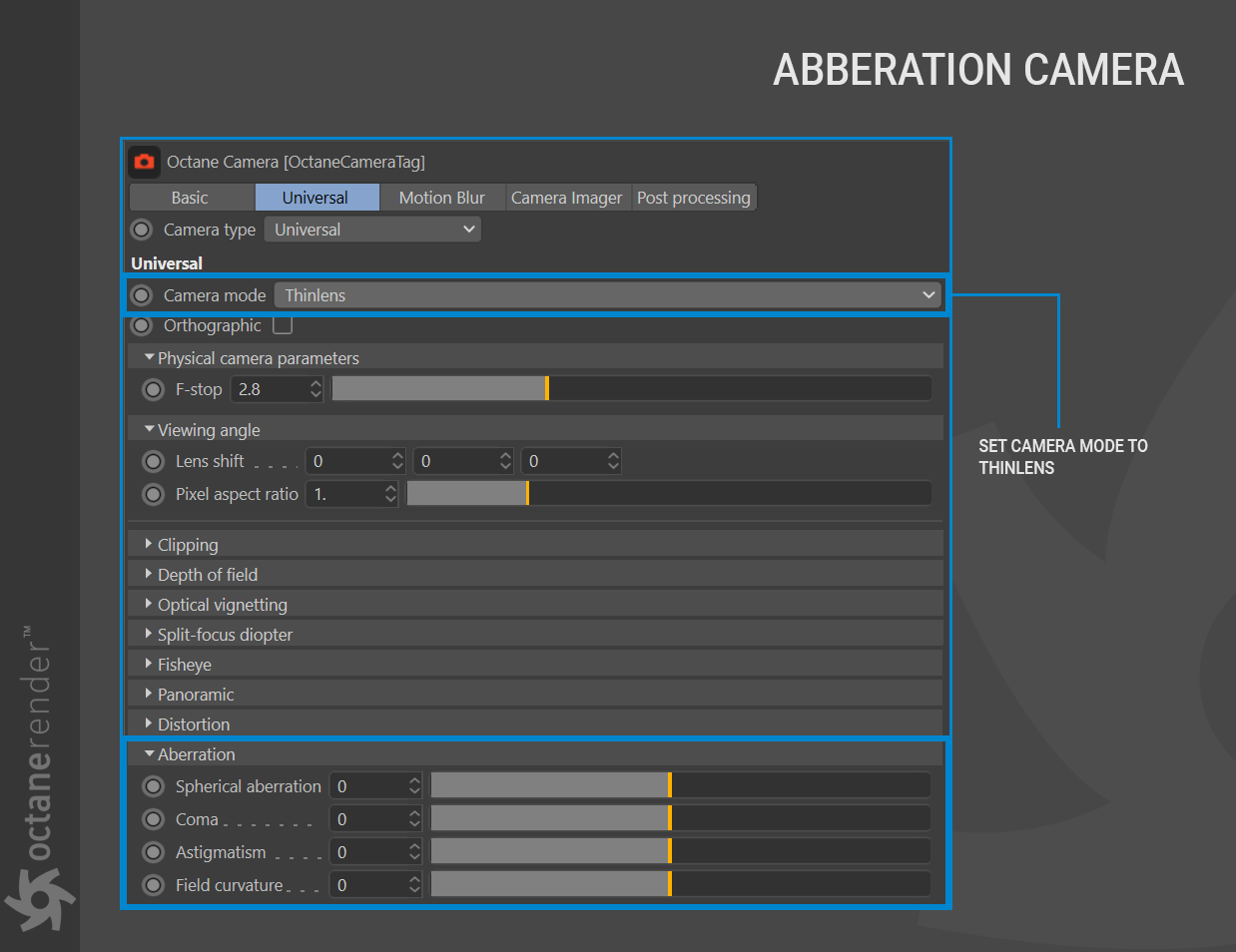Universal Camera
The Universal camera in OctaneRender® is a full-featured camera, with many features that mimic real world photographic lenses, and support for five different camera types:
- Thin Lens- The default Octane camera type.
- Orthographic- Removes any perspective from the image.
- Fisheye- Ultra-wide angle/spherical result, driven by the parameters discussed here
- Equirectangular- Special purpose format, driven by the Panoramic attributes discussed here
- Cubemap- will reproject the environment into a series of image rectangles within the frame composition, as determined by the Cubemap layout in the Panoramic section

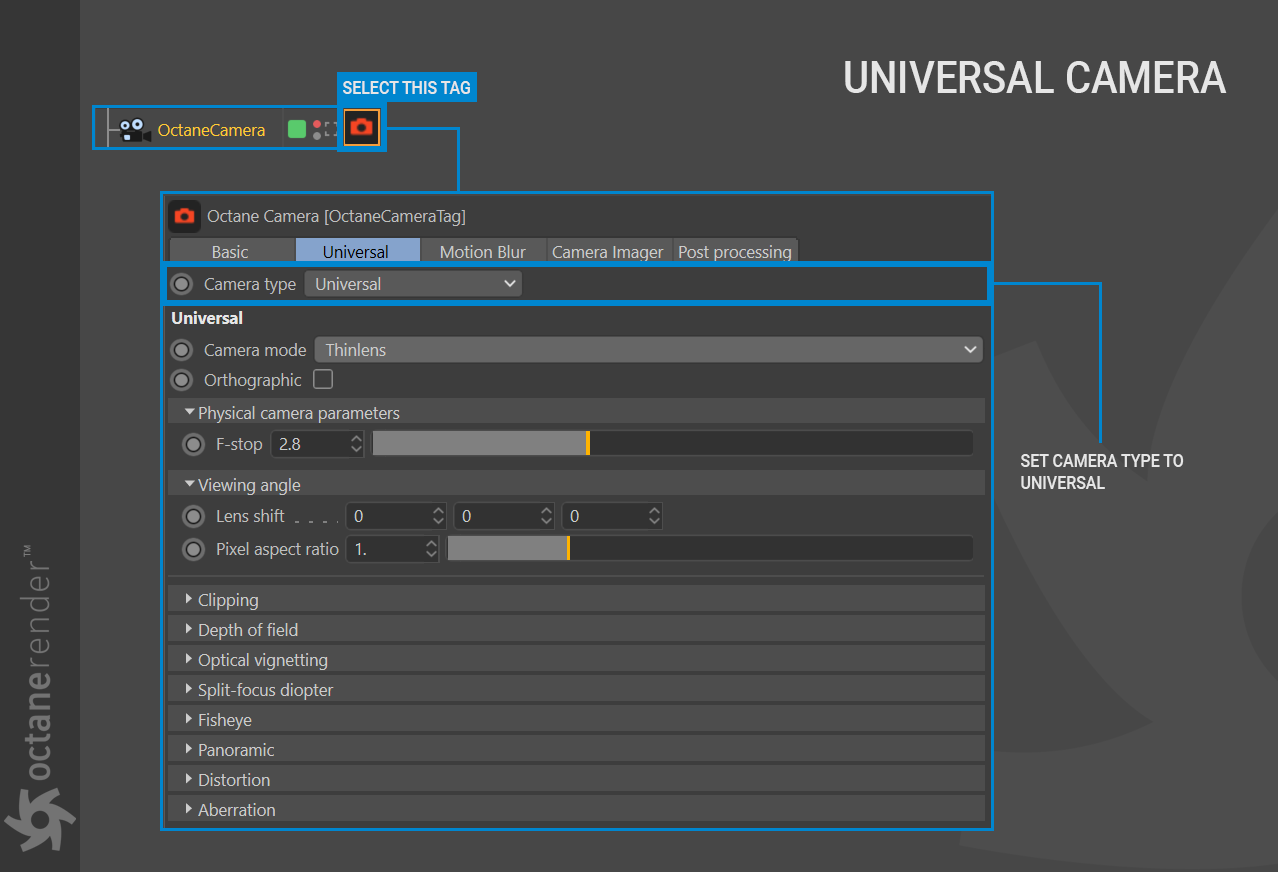
PHYSICAL CAMERA PARAMETERS
- F-STOP - The aperture-to-focal-length ratio.
VIEWING ANGLE
Refers to the area that is visible to the camera lens. These attributes below are affected by the values found in the Object tab of the OctaneCamera object main attribute panel.
- LENS SHIFT - The lens shift on X, as a factor of the image width and on Y, as a factor of the image height. The third value is ignored.
- PIXEL ASPECT RATIO - The X:Y aspect ratio of the rendered pixels
Clipping
**
- NEAR CLIP DEPTH - Distance from the camera to the nearest clipping plane, measured in meters.
- FAR CLIP DEPTH - Distance from the camera to the farthest clipping plane, measured in meters.
DEPTH OF FIELD
Depth of field refers to the distance between the closest and furthest objects in frame that are in focus.
Depth of field is dependent upon the F-stop value, in addition to the parameters listed below. DOF will be stronger when the F-stop value is closer to 0.
_
- AUTO-FOCUS - Keeps the focus on the closest visible surface at the center of the image, regardless of the aperture, the aperture edge, and focal depth values. This setting is on by default.
- FOCAL DEPTH - The depth of the plane in focus, measured in meters. If you are having trouble seeing a result when you adjust this setting, double-check to make sure that Auto-Focus is enabled. Auto-Focus overrides the Focal Depth setting.
- APERTURE - The radius of the camera’s lens opening, measured in centimeters. Low values have a wide depth-of-field, where everything is in focus. High values have a shallow depth-of-field, where objects in the foreground and background will be out of focus.
- APERTURE ASPECT RATIO - This allows users to squash and stretch the depth-of-field disc.
- APERTURE SHAPE - Controls the shape of the aperture.
- Circular
- Polygonal
- Notched
- Custom Aperture - Sets the custom aperture opacity map. The projection type must be set to OSL Delayed UV.
- APERTURE EDGE - Modifies the relative distribution of rays across the aperture, impacting the hardness of the edges of bokeh shapes. A value of 0 will result in no discernible depth of field. Higher values increase the contrast towards the edge. Values between 0 and 1 simulate an apodization filter.
- BLADE COUNT - The number of blades forming the iris diaphragm.
- APERTURE ROTATION - The rotation of the aperture shape in degrees.
- APERTURE ROUNDEDNESS - The roundness of the blades forming the iris diaphragm.
- CENTRAL OBSTRUCTION - Simulates the obstruction from the secondary mirror of a catadioptric system. This option is only enabled on circular apertures.
- NOTCH POSITION - Determines the position of the notch on the blades, active when the Notched Aperture Shape is chosen.
- NOTCH SCALE - Scale of the notch, active when the Notched Aperture Shape is chosen.
OPTICAL VIGNETTING
Referring to the darkening of an image towards the edges of the frame or lens barrel boundary, this is due to the phenomenon known as “light falloff.” This artifact can be used to draw the viewer’s gaze towards the center of the image frame.
- DISTANCE - The distance between the lens and the opening of the lens barrel.
- SCALE - The scale of the opening of the lens barrel relative to the aperture.
SPLIT-FOCUS DIOPTER
The split focus feature allows focusing the camera into two separate regions. This effect mimics lens diopter filters that would be attached to the front of a given lens to achieve the effect in real world optics. The attributes are defined below:
- ENABLE - Enables the split-focus diopter.
- DIOPTER FOCAL DEPTH - Depth of the plane in focus measured in meters.
- ROTATION - Rotation of the split-focus diopter in degrees.
- TRANSLATION - Translation of the split-focus diopter.
- BOUNDARY WIDTH - Width of the boundary between the two fields.
- BOUNDARY FALLOFF - Controls how quickly the Split-Focus diopter focal depth blends into the main focal depth.
- SHOW GUIDE - Displays guidelines toggling this option on or off will restart the render.
The images that follow show the split focus diopter in action. 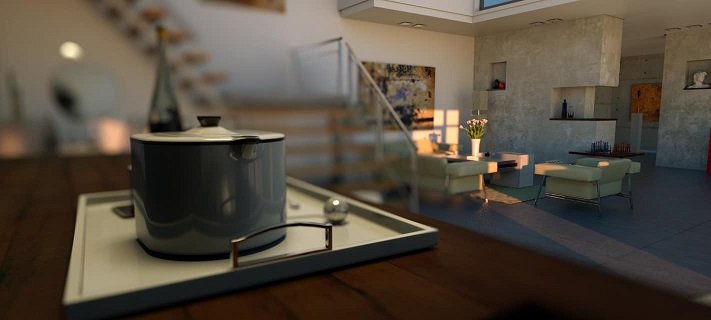
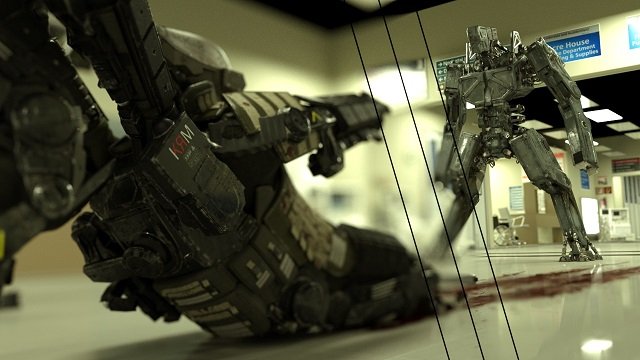
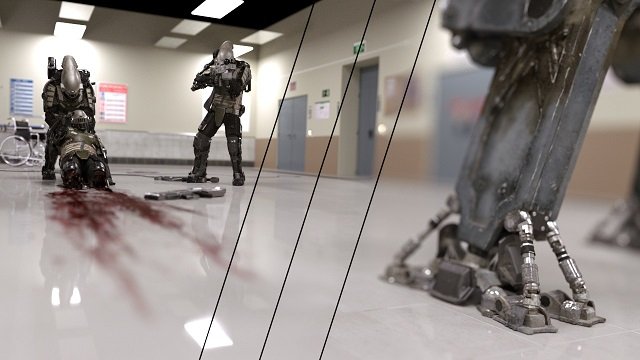
ORTHOGRAPHIC
Orthographic or Isometric projections show the scene without any perspective distortion. Typically, orthographic projections are what is shown in Cinema’s Front, Top and Side viewports, whereas Isometric projections are shown in the 3D Parallel viewport. To render an isometric view, set the Octane camera type to Universal, and the camera mode to Orthographic and enable the orthographic toggle underneath the menu. Set the Cinema camera projection to **Camera Object > Object tab > Projection menu: Parallel.** The results in Live Viewer will match that of the Cinema viewport. It might be necessary to tweak the values in the tab, such as the Zoom value.
Requires the Camera mode to be set to “Orthographic” and the Orthographic toggle be enabled.
_
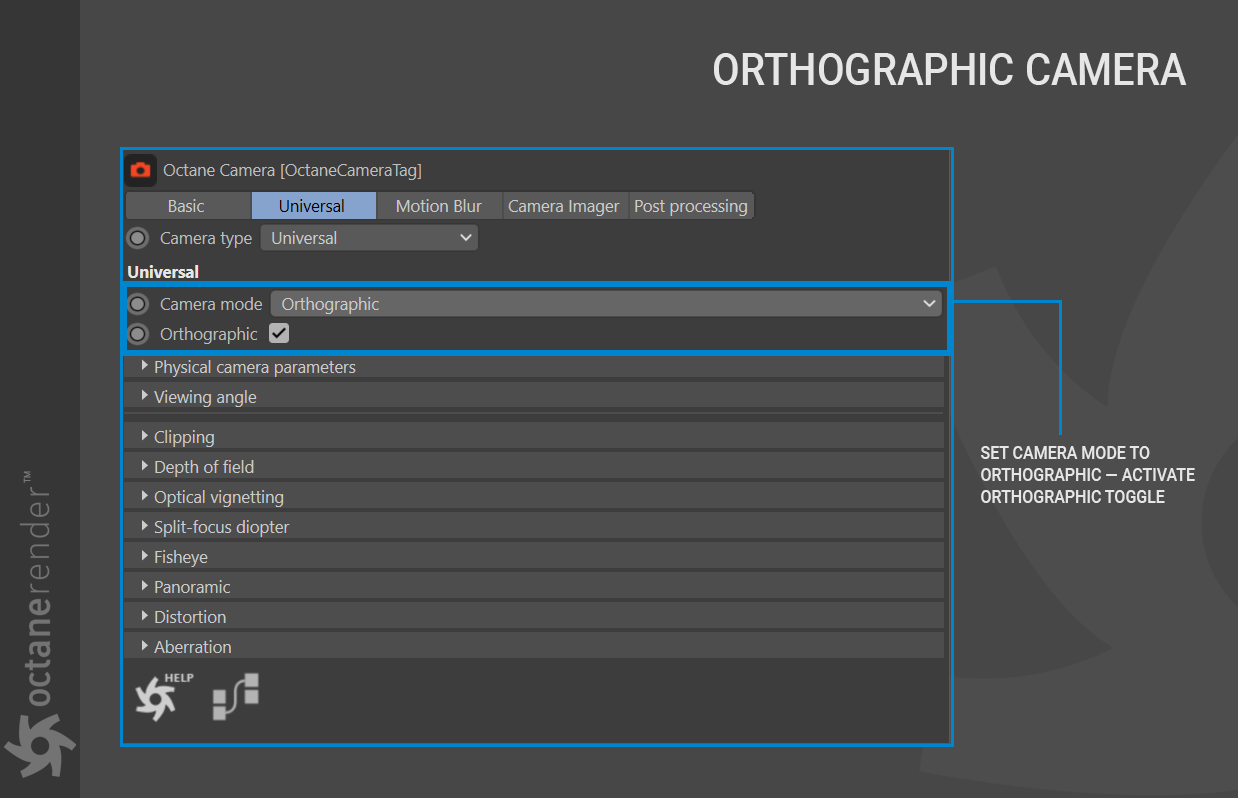
FISHEYE
Fisheye lenses provide an enormous viewing angle, distorting the image into a wide panorama or hemispherical shape. This effect is necessary for virtual reality (VR) headsets. Planetarium projectors also use special spherical lenses for projecting stars and other astronomical phenomena onto domes.
Requires the Camera mode be set to “Fisheye.”
_
- FIELD OF VIEW - The camera’s field of view, measured in degrees.
- FISHEYE TYPE - Choose between covering the lens circle in the sensor or covering the whole sensor.
- HARD VIGNETTE - Renders the lens (Circular fisheye only).
- FISHEYE PROJECTION - The projection function used for the fisheye.

PANORAMIC
Panoramic lenses can be used to create special purpose image formats often used for virtual reality or augmented reality applications. Real world cameras often require several images to be stitched together to form the result that this feature can achieve directly.
Requires the Camera mode be set to “Equirectangular.”
_
- HORIZONTAL FIELD OF VIEW - The horizontal field of view, in degrees. This sets the X-coordinate for the camera’s horizontal field of view in the scene. This is ignored when cube mapping is used.
- VERTICAL FIELD OF VIEW - The vertical field of view, in degrees. This sets the Y-coordinate for the camera’s vertical field of view in the scene. This is ignored when cube mapping is used.
- CUBEMAP LAYOUT - Determines the configuration for laying out the cubemap.
- EQUI-ANGULAR CUBEMAP - Activates an equi-angular cubemap projection.
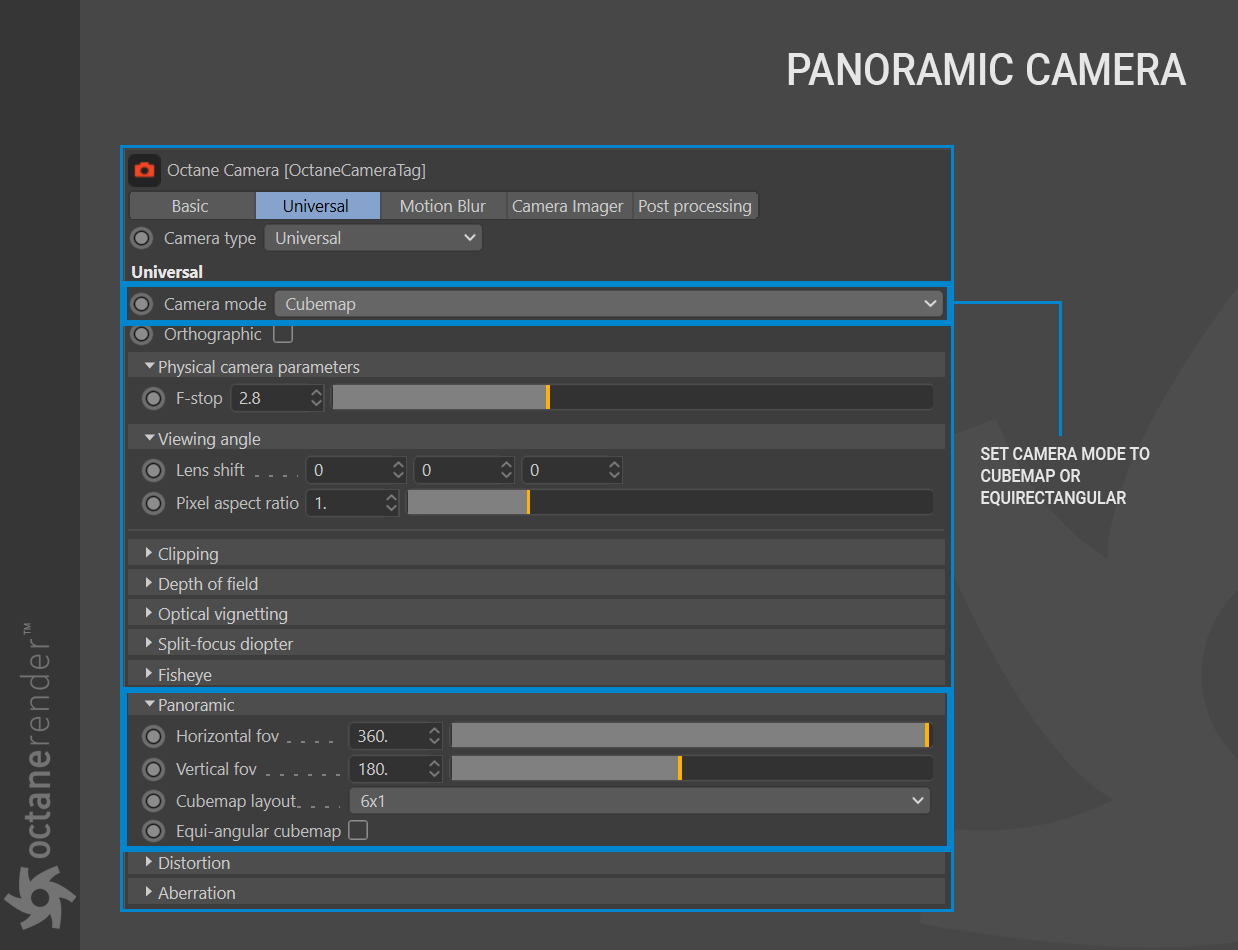
DISTORTION
Lenses in the real world are never perfectly manufactured, and often suffer various artifacts, one of which is distortion. Many image processing applications can remove distortion from an image. In some cases, it may be necessary to introduce lens distortion in order to match the appearance of live action photography.
Requires the Camera mode be set to “Thinlens.”
- USE DISTORTION TEXTURE - Enables the distortion texture.
- DISTORTION TEXTURE - The Distortion texture input.
- SPHERICAL DISTORTION - The amount of spherical distortion.
- BARREL - Straight lines appear curved.
- BARREL (CORNERS) - Straight lines appear curved, affecting corners.
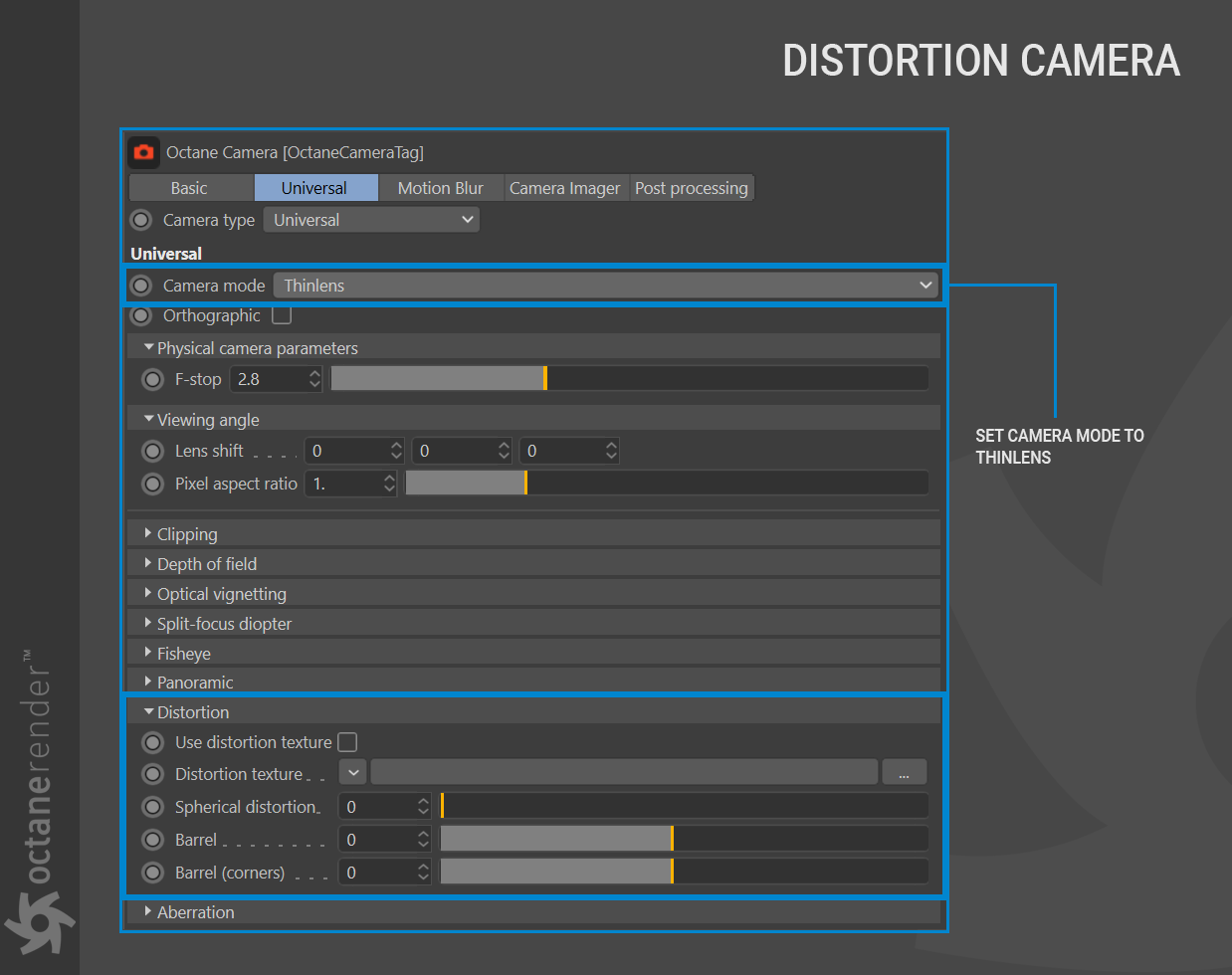
ABERRATION
As with Distortion, Aberration also occurs in real world lenses. Aberration produces a variety of visual artifacts which the Universal camera can reproduce.
- SPHERICAL - Rays hitting the edge of the lens focus closer to the lens.
- COMA - Rays hitting the lens edge have a larger field of view.
- ASTIGMATISM - Sagittal and tangential rays focus on different distances from the lens.
- FIELD CURVATURE - The curvature of the plane in focus.
